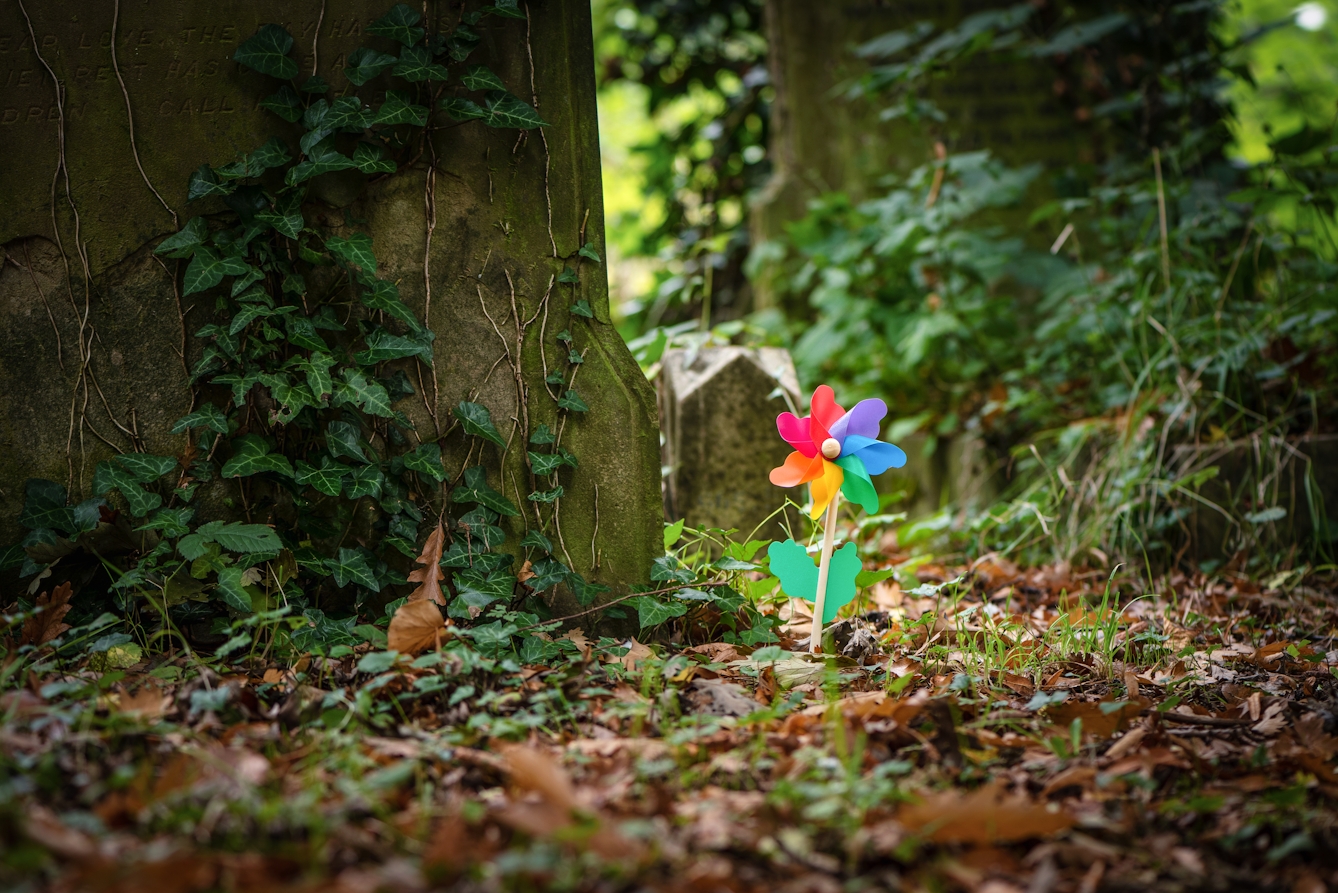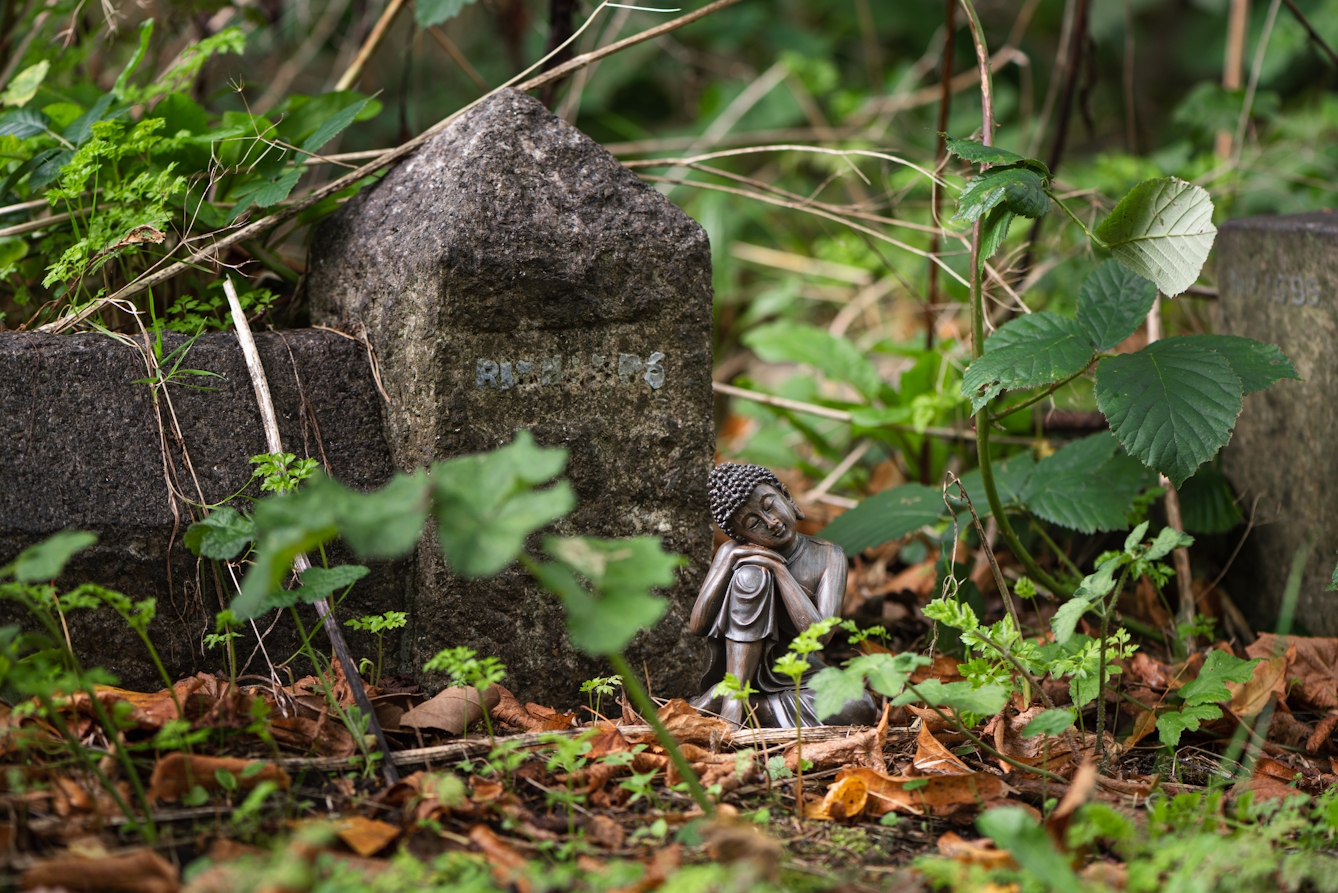Children’s graves adorned with teddies, ornaments and even messages asking Santa to stop by show how bereaved parents continue to look after their child. When council rules threatened to limit grave offerings, Wendy Pratt fought back. She explains how caring for her daughter’s grave helped her grieve.

Before my daughter died, the idea of the cemetery was an abstract concept. If I had considered it before, I would never have equated the scrubbing of a headstone and the trimming of grass with what our ancestors had done before us. They left flint blades and precious items in graves, and in one Mesolithic example, a swan's wing beneath a baby’s body. It seems difficult to understand what the people who buried the baby on the swan’s wing were thinking 6,000 years ago, but somehow the bereaved mother in me does know.
Mother’s Day 2018
As I parked at the entrance to the children’s section I saw, immediately, that something had changed. White laminated signs had appeared, pocking the peaceful landscape like fungi. The signs were written in the sort of tone that might politely ask you to be considerate and wash your own cups up in the office tea room. Instead they said that the council wanted the grave owners to remove all grave goods, except flower planters, leaving nothing that would impede maintenance or look messy.
They were enforcing a rule that was already in the guidebook they gave me eight years before, when I was crawling over the rubble of my obliterated world and my thoughts were elsewhere. I barely remember that day, when we came to pick her plot. I remember there was a man kneeling over the grave that would be next to my daughter’s. He was crying. He was clawing his fingers into the ground and he was crying. We didn’t bat an eyelid because this was our new normal.
On my daughter’s grave were two small children’s windmills, a pot of daffodils, an insect house for ladybirds to hibernate in, a tiny birdbath, an ornament of a hare, a tiny Buddhist statue, all of which were breaking the rules. I read the sign over and over.
They’d assessed the graves. Someone had been to my daughter’s grave and measured the size of the little fence, the pots, the toys, to see if it complied with the rules. Someone may have put their foot on the small plot of her grave and leaned over, nudging her things to one side to take measurements. They might as well have stood on her body.

Windmill.
Rosebuds on a white coffin
They never use the hearse for babies. The funeral director tells us that it “looks too sad” to see such a tiny coffin in the back of the hearse. Instead, on the day of her funeral in 2010, my husband and I held hands across our daughter’s white coffin as we rode in the back of a black limousine. I kept thinking about the definitive nature of the day, that this was the last time that the three of us would be together. I felt stretched open, emptied out of an entire person.
Our first grave gifts went into her coffin: a letter from each of us, a photo and a teddy bear. As the limousine drove down the avenue of blossoming trees, the pink petals drifted in great pink swathes across the road. Then we were at the grave, and the hole in the ground was waiting to swallow our baby up, and I suddenly knew why they use the green baize around the edges: because the reality of putting your baby in a hole in the ground is too hard.
I watched a few stray pink petals float into the black. I didn’t want anyone to throw earth into the grave – it was too much like throwing it in her face. Instead we tore the rosebuds off the flower displays, kissed them and threw them in. They made a sound like cat paws on glass.
The week after the funeral
We were so lost. We bought lilies from a proper florist. There was no headstone yet. The earth was visible beneath the grass, like a mouth with lips that wouldn’t shut. We took our cue from what others were doing, walked round the children’s section as if in a showroom for the bereaved.
Some of the graves have LED solar-powered lights that come on after dark. The council will insist that people complain about the cemetery looking like a disco because of them, but we, the collective of the buried children, know that when your child is alone in the dark and the cold, you want to leave a light on so they won’t be frightened, even if they’re dead.
When your child is alone in the dark and the cold, you want to leave a light on so they won’t be frightened.
Some of the graves are adorned with teddies that have mouldered in the wet, some with flowers, ornaments, cherubs. There are some that look like gardens. Each one is as individual as the child, as individual as the parents. We decided we wanted the grave to attract wildlife – insects, birds, squirrels. We are animal lovers and have always pictured her with the dog and cat and helping Mummy with the rabbits.
When your child dies, especially if it’s a shock, it’s like something is severed. There is a strangeness to the sudden change in perception. Halloween, in particular, becomes uncomfortable; the small plastic headstones that make up shop window displays and ‘R.I.P.’ iced onto cakes suddenly feels wrong. There’s no connection to the dead in the modern Halloween; they are characterised as something to be feared. Everything you know about corpses changes, because your perfect child who looks as if they are sleeping is now also a corpse.
I had quite a lot of therapy to help me deal with the loss of our baby, though looking back, the grave site didn’t feature very heavily in my own talking therapy. I would have benefited from some literature from the council or the cemetery itself that explained the importance of the grave in the grieving process.

Insect house.
Caring for your dead child
It seems to me that a cemetery is such a huge part of any town physically, but isn’t a part of the community in any real sense. Instead it has the feeling of being a storage facility for the dead. Yet in other cultures the cemetery is embraced by the people who use it.
In Mexico, on the Day of the Dead, people gather at the graves of their relatives to drink the deceased’s favourite drinks, play music, eat their favourite foods. In Sweden, on All Saint’s Day each grave is lit up with candles so that the cemetery can be seen from anywhere and remembered. In some South American cultures, the dead are emptied from their coffins, cleaned and redressed each year in a continuing act of love.
Yet in British culture it would appear that we are intent on maintaining a stiff upper lip, stoically neatening cemeteries out of all personalisation. With this said, it is clear that the instinct to care for your child does not die with your child: it overrides anything else. If you visit the children’s section of any cemetery on Christmas Day you will see an array of Christmas trees, sparkling fairy lights and even signs that plaintively beg “Santa Please Stop Here”.
Dr Gary Wilshaw, a mental health nurse and therapist who has cared for patients dealing with grief in different forms explains the role of grave goods in the grieving process in terms of communication: “People exist constantly in a state of being in relation to others… When a loved one dies, their absence does not end this state of relatedness. The relationship persists and the survivor’s actions can be understood in this context. In general, parents are predisposed to care for and nurture their children. Burial beneath the ground is antithetical to this drive and yet this must be somehow dealt with.”

Buddhist statue.
Remembering my daughter
By 2012 I was no longer visiting the grave every day. I was visiting every week. Then I had a miscarriage and my grave visits became more structured and ritualistic again as I struggled with guilt over the fact that I had tried to move away from the baby in the ground and tried to have a new, live baby. This manifested itself in my need to have something to ‘do’ at the grave.
I also struggled with feelings around not being a real mum. No one else knew my daughter except myself and my husband, and I am the only one who knew her as a living, kicking, moving baby, as someone who was different from me, as someone who existed. I felt I had to prove her existence. I took it as my responsibility to ensure that no one forgot that she existed.
New graves began to arrive. I watched the newly bereaved move through their grief; the daily visits that become weekly, monthly. Some graves became untended. Some parents went on to have new babies, and more often than not, these were the families who appeared less frequently to tend the graves. Without the focus of a new baby to absorb my maternal instincts, I clung to the care I gave our daughter’s grave. It has been a long journey to find a catalyst within my own needs to justify to myself (and my daughter?) that less time spent by her headstone is acceptable.
Surprisingly, I didn’t mark the miscarriages I went on to have in any way at all. Though I grieved for the two small lives we briefly created, there was not the same need to care for them. However, having spent some time supporting parents who have lost babies in the infertility community, I have seen lots of people do just this: taking their baby’s cherished remains home, at whatever stage they were lost, to bury in plant pots and gardens, creating spaces to grieve, tables with pictures of the embryonic scans, beautifully cared-for shrines.
There is a direct equivalence between investment, love and grief. Even the process of actively trying to conceive is a weight that can be measured against the sudden drop when the opposite weight – the baby, whether physical or not – is removed.

Daffodils.
Looking after other bereaved parents
By 2018 we had stopped trying to conceive and decided to embrace a child-free future. The grave is now not only the place of my daughter’s remains, but is symbolic of a period of time spanning 13 years of trying to have a family.
I fought the council on the enforcement of the rules. A thousand people signed my petition. I went on the radio to argue for the need for grief to find its own way, for the special circumstances that child loss brings. This is also about being a mum, about looking after my daughter, about looking after the other parents, newly initiated into the club that no one wants to be in.
We win. The protocols are changed; the children’s graves are exempted from the rules. I take flowers from the supermarket, roses and a bunch of expensive lilies. I kiss my hand to the headstone and tell her she is not forgotten.
About the contributors
Wendy Pratt
Wendy Pratt is a former biomedical scientist and now a widely published writer and award-winning poet who also offers mentoring to other writers. Her latest collection, ‘Gifts the Mole Gave Me’, was published in 2017. She lives in North Yorkshire.
Thomas S G Farnetti
Thomas is a London-based photographer working for Wellcome. He thrives when collaborating on projects and visual stories. He hails from Italy via the North East of England.

